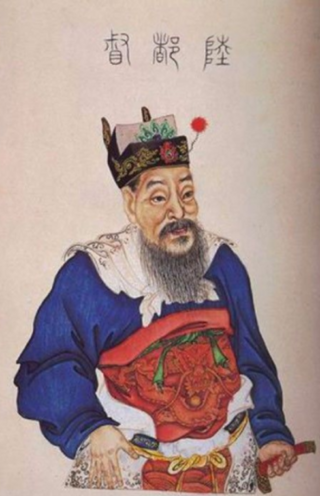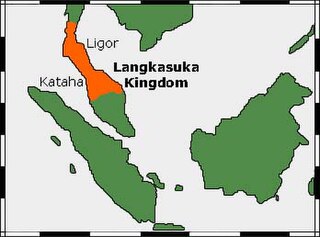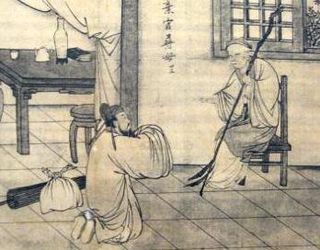
Sima Qian was a Chinese historian of the early Han dynasty. He is considered the father of Chinese historiography for his Records of the Grand Historian, a general history of China covering more than two thousand years beginning from the rise of the legendary Yellow Emperor and the formation of the first Chinese polity to the reigning sovereign of Sima Qian's time, Emperor Wu of Han. As the first universal history of the world as it was known to the ancient Chinese, the Records of the Grand Historian served as a model for official history-writing for subsequent Chinese dynasties and the Chinese cultural sphere up until the 20th century.

Lu Kang, courtesy name Youjie, was a Chinese military general and politician of the state of Wu during the Three Kingdoms period of China. He was the second son of Lu Xun, the third Imperial Chancellor of Wu. Lu Kang inherited the mantle of his father but was less involved in politics as he served mainly in the Wu military. He rose to prominence during the reign of the fourth and last Wu emperor, Sun Hao. In 272, he successfully suppressed a rebellion by Bu Chan and fended off invading forces from Wu's rival, the Jin dynasty. After the Battle of Xiling, he actively pursued a policy of détente with the Jin general Yang Hu at the Wu–Jin border. At the same time, he constantly submitted memorials to Sun Hao, urging the tyrannical emperor to change his ways and govern with benevolence, but his advice fell on deaf ears. In 280, about six years after Lu Kang's death, the Jin dynasty launched a campaign against Wu and conquered Wu within a year.

Han Xin was a Chinese military general and politician who served Liu Bang during the Chu–Han Contention and contributed greatly to the founding of the Han dynasty. Han Xin was named as one of the "Three Heroes of the early Han dynasty", along with Zhang Liang and Xiao He.

Langkasuka was an ancient Hindu-Buddhist kingdom located in the Malay Peninsula. The name is Sanskrit in origin; it is thought to be a combination of langkha for "resplendent land" -sukkha for "bliss". The kingdom, along with Old Kedah, is among the earliest kingdoms founded on the Malay Peninsula. The exact location of the kingdom is of some debate, but archaeological discoveries at Yarang near Pattani, Thailand suggest a probable location. The kingdom is proposed to have been established in the 1st century, perhaps between 80 and 100 AD.

Jia Xu, courtesy name Wenhe, was an official of the state of Cao Wei during the early Three Kingdoms period of China. He started his career in the late Eastern Han dynasty as a minor official. In 189, when the warlord Dong Zhuo took control of the Han central government, he assigned Jia Xu to the unit led by Niu Fu, his son-in-law. In May 192, after Dong Zhuo was assassinated by Lü Bu, Jia Xu advised Li Jue, Guo Si and Dong Zhuo's loyalists to fight back and seize control of the imperial capital, Chang'an, from a new central government headed by Lü Bu and Wang Yun. After Li Jue and the others defeated Lü Bu and occupied Chang'an, Jia Xu served under the central government led by them. During this time, he ensured the safety of the figurehead Han emperor, Emperor Xian, who was being held hostage by Li Jue. He also attempted to prevent internal conflict between Li Jue and Guo Si, but with limited success. After Emperor Xian escaped from Chang'an, Jia Xu left Li Jue and briefly joined the general Duan Wei before becoming a strategist of the warlord Zhang Xiu. While serving under Zhang Xiu, he advised his lord on how to counter invasions by the warlord Cao Cao, who had received Emperor Xian in 196 and taken control of the central government. In 200, during the Battle of Guandu between Cao Cao and his rival Yuan Shao, Jia Xu urged Zhang Xiu to reject Yuan Shao's offer to form an alliance and instead surrender to Cao Cao. Zhang Xiu heeded his advice. Jia Xu then became one of Cao Cao's strategists.

Lin Shu (Chinese: 林紓, November 8, 1852 – October 9, 1924; courtesy name Qinnan was a Chinese man of letters, especially for introducing Western literature to a whole generation of Chinese readers, despite his ignorance of any foreign languages. Collaborating with others, he translated from English or French into Literary Chinese over 180 works, mostly novels, drawn from 98 writers of 11 countries.

Tao Qian (132–194), courtesy name Gongzu, was a government official and warlord who lived during the late Eastern Han dynasty of China. He is best known for serving as the governor of Xu Province.

Zuo Qiuming, Zuoqiu Ming or Qiu Ming was a Chinese historian who was a contemporary of Confucius. He lived in the State of Lu during the Spring and Autumn period. He was a historian, litterateur, thinker and essayist who worked as a Lu official.
Di Zi Gui was written in the Qing dynasty during the reign of the Kangxi Emperor by Li Yuxiu. The book is based on the ancient teaching of the Chinese philosopher Confucius that emphasises the basic requisites for being a good person and guidelines for living in harmony with others. Like the San Zi Jing, it is written in three-character verses. The source for the main outline of it is from Analects of Confucius, Book 1, Chapter 6, where Confucius said:
A young man should be a good son at home and an obedient young man abroad, sparing of speech but trustworthy in what he says, and should love the multitude at large but cultivate the friendship of his fellow men. If he has any energy to spare from such action, let him devote it to making himself cultivated.

The Twenty-four Filial Exemplars, also translated as The Twenty-four Paragons of Filial Piety, is a classic text of Confucian filial piety written by Guo Jujing (郭居敬) during the Yuan dynasty (1260–1368). The text was extremely influential in the medieval Far East and was used to teach Confucian moral values.
In the study of the classic Chinese novel Dream of the Red Chamber, the Cheng-Gao versions or Cheng-Gao editions (程高本) refer to two illustrated, woodblock print editions of the book, published in 1791 and 1792, both entitled The Illustrated Dream of the Red Chamber (绣像红楼梦). The 1791 version, produced at the year's end, was the novel's earliest print edition. A revised edition, differing in minor details, was published less than eighty days after the first print edition in early 1792. Both editions were edited by Cheng Weiyuan (程伟元) and Gao E and were published by Suzhou's Cuiwen Book House (萃文书屋).
Little China is a term referring to a politico-cultural ideology and phenomenon in which various Japanese, Korean and Vietnamese monarchs identified themselves as the "Central Kingdom" or "Central State," and regarded themselves to be legitimate successors to the Chinese civilization. Informed by the traditional Chinese concepts of Sinocentrism and Hua–Yi distinction, this belief became more apparent after the Manchu-led Qing dynasty had superseded the Han-led Ming dynasty in China proper, as Tokugawa Japan, Joseon Korea and Nguyễn Vietnam, among others, perceived that "barbarians" had ruined the center of world civilization.
Zhang Changpu (199–257) was a concubine of Zhong Yao, a high minister of the state of Wei in the Three Kingdoms period of China. She was also the mother of Zhong Hui, a Wei general who played a significant role in the conquest of Wei's rival state, Shu, in 263. Her given name was not recorded in history; "Changpu" was actually her courtesy name. According to her biography written by Zhong Hui, she was a strict mother to Zhong Hui and played a significant role in his early education. She was also known for her virtuous conduct and wisdom.

The Yiqiejing yinyi is the oldest surviving Chinese dictionary of Buddhist technical terminology, and was the archetype for later Chinese bilingual dictionaries. This specialized glossary was compiled by the Tang dynasty lexicographer monk Xuanying (玄應), who was a translator for the famous pilgrim and Sanskritist monk Xuanzang. When Xuanying died he had only finished 25 chapters of the dictionary, but another Tang monk Huilin (慧琳) compiled an enlarged 100-chapter version with the same title, the (807) Yiqiejing yinyi.
Xu Ci, courtesy name Rendu, was an official and scholar of the state of Shu Han in the Three Kingdoms period of China. An outsider to the province, he and Hu Qian's disorderly conduct would hamper a scholarly project and see his superior put on a play mocking the poor conduct of those involved.
Du Qiong, courtesy name Boyu, was an official, astronomer and diviner of the state of Shu Han in the Three Kingdoms period of China.
The Four Perils are four malevolent beings that existed in Chinese mythology and the antagonistic counterparts of the Four Benevolent Animals.
Pei Wei (267–300), courtesy name Yimin, was a Chinese essayist, philosopher, physician, and politician of the Western Jin dynasty. He was the cousin of Jia Nanfeng and rose to prominence during the reign of her husband, the Emperor Hui of Jin. Pei Wei was seen by traditional historian as one of Empress Jia's exemplary supporters along with Zhang Hua and Jia Mo. He pushed for a number of significant reforms during his tenure which met with mixed success before his execution by the Prince of Zhao, Sima Lun, in 300 following Sima Lun's coup.
Shaozheng Mao, was a Lu state Taifu in the 6th century BC.










